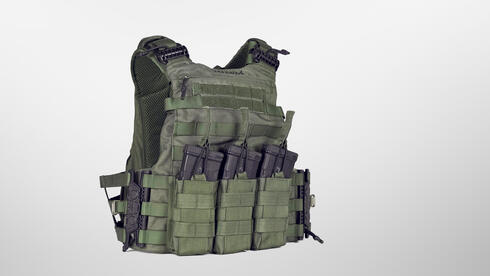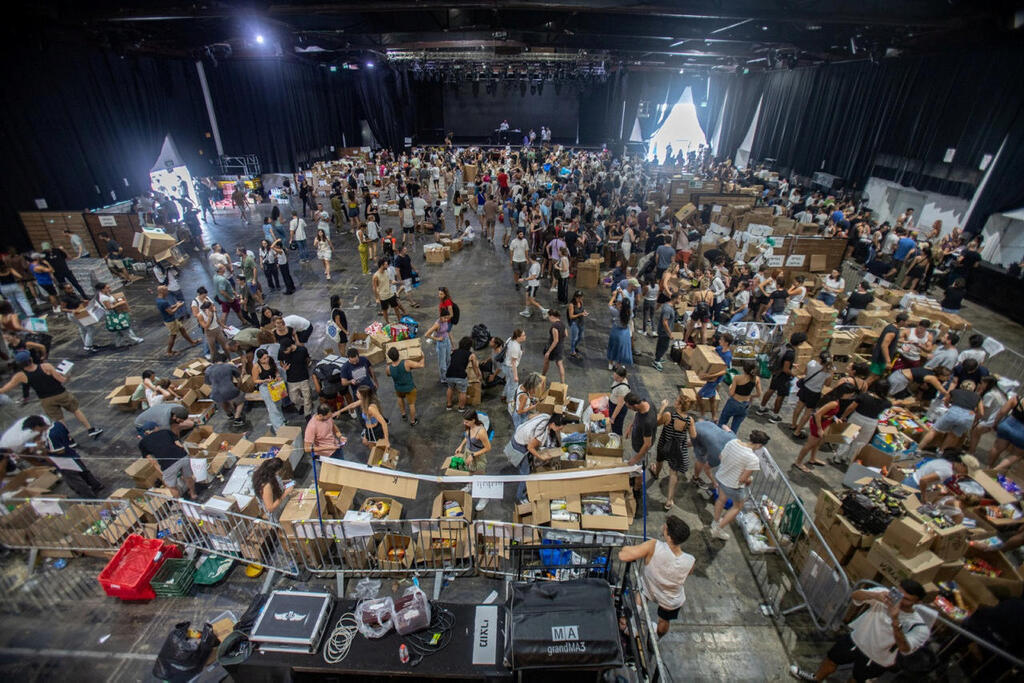
From battlefield to bargain bin: IDF soldiers flood online market with unused combat equipment
The severe shortage of combat equipment since October 7 led to a flood of private donations, and many surpluses, which are now being sold online, on second-hand sales platforms
"Meprolight M5 sight - 2,500 shekels", "Infrared night vision equipment for a range of up to 250-300 meters, price: 450 shekels", "Tactical helmet on sale, 1,200 shekels instead of 1,260", "Ceramic belt plates level 4, price has dropped from NIS 1,800 to 1,700" - these ads and hundreds of similar ones have been filling the online sales and buying boards on Facebook, Yad2 and Telegram in recent days. Behind each of the ads there is a story.
Calcalist spoke with IDF soldiers who returned home with private combat equipment, which was not used, with an aggregate value of tens and hundreds of thousands of shekels. Some of them store this equipment in their home for future use, but the rest prefer to sell it for financial gain. As one of the ads on Facebook explains: "Sold due to leaving Gaza and returning to normal, I will not need these things."
But the big story here is not some reservist who wants to make a small fortune in times of war and recession. The multitude of these ads is mainly indicative of the bigger and sadder story - the story of an army that neglected its mission and failed to provide basic combat equipment to the reservists it sent to fight Hamas and Hezbollah.
The result is chaos - surpluses in one place, which are rolled into the private market, and shortages in another, which are evident in many ads of fighters who are still looking for equipment. "Looking for a Meprolight sight, preferably with an adapter! I finally joined the reserves and the unit was missing sights, looking for one because I had one during my mandatory service and know how to work with it," one of the ads read. Another ad, in which an armored corps officer asked for a helmet, vest and ceramic shield ("If there are people here who are done with the equipment and believe in simply passing on their equipment, I'm more than happy to accept it"), even received critical responses from people who suggested that he open his wallet instead of expecting people to open their hearts to him.
And when the chaos in military equipment goes wild, the scammers and crooks also flourish. Although most of the online sales ads offer private equipment bought by donors, there are quite a few ads that offer stolen original IDF equipment. "Selling two pairs of new infantry boots," one ad reads. In other ads, a "deal" was offered to replace a light IDF ceramic vest with a tactical helmet; a weapon strap and a helmet cover for a standard IDF helmet ("only NIS 20"); and even a Meprolight sight, engraved with a serial number, for NIS 2,000. The seller insisted that it was made for the private market, but agreed to be flexible on the price, because he does not know any more details about its origin. "A friend of my father brought it," he wrote.
The inflation of private combat equipment is a relatively new event, which began to gain momentum after the events of October 7 and the extensive reserve mobilization that began in their wake. Many fighters who were sent to the war in Gaza and the northern border found themselves with outdated, missing or irrelevant equipment. After realizing that the IDF was unable to keep up and provide them with an answer, they turned to donors or social networks for help.
"We were sent to the reserves on October 7, but already on the way to the base we were actually told not to arrive yet, because there is a shortage of equipment and there is a shortage of weapons. That's when we realized how serious the situation in the unit is," says G, an IDF reservist. "I talked about it with a member of the team, who was just on his way to synagogue, so he raised a few thousand shekels from the worshipers on the spot, with which we bought kneepads that very day, so that our knees wouldn't break."
But the situation is much more serious than a lack of kneepads. "When we arrived at the unit, we saw that there were not enough weapons for everyone," recounts G. "People came with Blundstone shoes and they didn't have infantry shoes. They all had iron sights, instead of optical sights. There just wasn't enough equipment. It makes me very annoyed, because we were always told regularly that in war, the military uniform storage units would be opened and everyone would receive knee pads, a vest, a helmet and night vision equipment, but in practice there was nothing. There was a feeling of panic."
As a first step, G contacted people he knew and prepared a paybox group that was forwarded on WhatsApp to everyone who was willing to donate. "We asked for donations even though some of the guys didn't like it. Parents donated money, friends too, and we raised NIS 30,000 that way, but it wasn't enough for the heavy stuff."
G's goal was to get a donation of optical sights - a goal he eventually achieved with help from outside Israel: "The matter with the iron sights was very annoying, we have to shoot at long ranges and it doesn't make sense. My wife has an uncle in America in a strong Jewish community. They raised several million shekels, some from New York and some from Florida, and not just for our unit. They donated equipment to us and some of it was stolen by people posing as soldiers from our unit. After this incident, the donor took matters into his own hands and got us a donation of Trijicon sights, which cost $1,300- $1,500 per unit in the open market, and flew them to Israel himself.
"We also received a donation from Joe Zevuloni, who raised a lot of money and bought ceramic vests and helmets for a lot of soldiers. Lately, he has been handing out drones. It made me very happy that we have such a strong support from Jews from America, but damn it, people here pay 40%-50% income tax and there is no way to fight without the equipment."
G explains that he did not coordinate the donation with any official in the IDF because he does not trust them. "If I had talked to them, they would have wanted it for their own purposes," he says. "We saw with our own eyes soldiers from the logistics corps walking around with mountain boots taking the donations for themselves." G also knew that if he reported that he had obtained a donation of mountain shoes, the IDF would not provide them with such shoes - after all, they already have them.
Another problem caused by the donations is the deepening of the gaps between the various military units - strong and prominent units such as the Golani and paratroopers will be able to obtain better equipment, while the Nahal, armor or engineering corps will have to make do with less. They are also probably the main buyers of the current second-hand sales.
The IDF's ambiguous attitude towards donations of private equipment is not accidental. In official statements the IDF claims that it opposes bringing private equipment to the fighters - but, in the field the units rely on donations in many cases. This is how cases arise where a soldier who has obtained a sight via donation will not receive a military sight, because in a situation of shortage the units prefer to give to those who do not have any at all.
There are three main reasons for the equipment crisis: the first is the increased mobilization of the reserves that was not expected. A senior officer says that "at the beginning of the war, much more than 100% of the people in each unit enlisted in the reserves, it was more around 130%." Other sources in the IDF say that in some units the recruitment rate even reached 200%, so that even in places where there was 120% preparation in terms of equipment, this was not enough.
The second reason is that the IDF was not prepared for an all-out war that would include the recruitment of hundreds of thousands of reservists. The Ministry of Defense claims that "everything the army asked for - we bought", pointing the finger of blame at the IDF, which was not prepared in terms of its attribution scenarios. "The army prepared with equipment according to what was planned. And on October 7, we discovered that we had not prepared for the correct reference scenario. We failed," admitted one officer.
The third reason is the equipment gaps between the reserve and regular army. In recent years, the IDF has significantly improved the equipment of the regular army. On the other hand, the reserve army, which constitutes the majority of the IDF's fighting force in an emergency, was not upgraded in the same manner and the soldiers in the field are aware of this gap, especially when regular and reservist soldiers sometimes receive the same operative tasks, only that the reservists are sent to them with a lower level of protection and less effective firepower.
Those who profited greatly from the rush to get equipped are the companies and importers that supply equipment to the soldiers. A manager of one of the companies that supplies combat equipment to the IDF estimated that in the last four months, tens of thousands of kits were sold for fighters, which are priced at 3,000-5,000 shekels for a basic kit (tactical helmet, vest and ceramic shielding). This means that the purchase of these products alone reached at least tens of millions of shekels since October 7, to which must be added peripheral equipment such as hiking equipment (shoes, flashlights, warm clothing, sleeping bags) and combat equipment such as sights and night vision devices.
"We ordered crazy amounts of stock for millions of shekels to meet the demands," says Daniel Shahar, owner of the Sbrs travel equipment store. "It really surprised us. We are a store that sells civilian equipment, travel equipment that brings a smile to the face. But when the war broke out, our entire store was flooded with buyers - shoes, warm equipment, mattresses, gloves, sleeping bags, jackets, flashlights, you name it. The Lowa boots, for example, became quite the fashion of the army. On a personal level, I didn't keep too much of this shoe in stock and suddenly there was the boom of the war, we sold all the supply we had, and even now there is a shortage of this boot."
Who are the buyers?
"It’s less soldiers, and more donors and associations that raised a lot of money from abroad. There are associations, such as former soldiers of the Duvdevan unit, who made a concentrated purchase, and there were all kinds of good Jews from America or France, who just entered the store, opened their pockets, loaded their car and drove to 'give it to the army'. And of course there were also a few charlatans who tried to take equipment at a reduced price in order to cash in on it."
Calcalist learned that in recent months the IDF has been working on a plan to reduce the equipment gap between reservists and regular soldiers, but this plan comes with a price tag of NIS 2 billion, and the army is skeptical about the possibility of it being budgeted.
"Let's not get confused, in terms of the defense budget it's peanuts," says R., a senior manager in the Israeli defense equipment industry, who also serves as an official supplier of combat equipment to the IDF. "Ultimately, this is a broken contract between the reservists and the system, which is why they don't trust the system and everyone wants their equipment under their bed at home, in case they are called to war tomorrow."
And there is another problem with the conduct of the IDF, even when it already intends to purchase equipment for the reservists: "If a donor arrives at the unit at noon, the equipment is already in the hands of the soldiers in the evening," says R. "But when the army undertakes a purchase, then it goes through a long process or approvals.” And in some cases the war will end before the equipment ever reaches the soldiers.
The IDF stated in response: "Equipping soldiers with military combat equipment is carried out in an orderly and professional procedure, which includes all the required tests, including suitability for purpose, quality and safety. In view of the large numbers of those called up for the reserves at the beginning of the campaign, and donations of equipment from civilians that do not conform to the standards defined by the IDF, a phenomenon of the introduction of non-standard equipment has developed. In light of this, the IDF's policy was clarified regarding the procedures that require receiving equipment in the IDF and a dedicated donation center was opened in cooperation with the Ministry of Defense. There is no purchase limit for civilian equipment. However, equipment that the IDF identifies as sensitive undergoes a deactivation process and is required to remain in the unit. We emphasize that equipment not provided by the IDF may create a significant risk to the forces."















